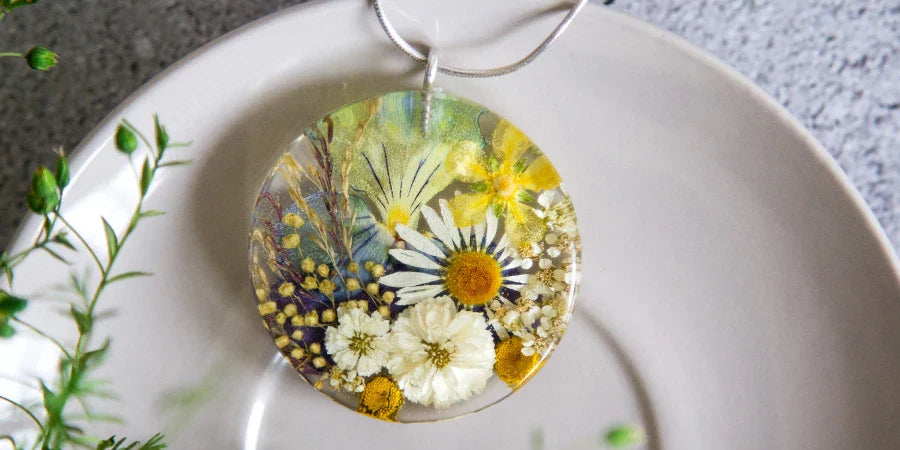What to Do When Flowers Are Not Drying from the Inside.
Properly drying flowers is crucial to retain their vibrant colours and delicate shapes. Despite following traditional drying methods like air drying and using silica gel, flowers may still not dry effectively from the inside, resulting in issues like drying out or mould growth. This can be frustrating for anyone looking to preserve flowers for crafts or keepsakes. If you've encountered this issue, don't worry! Expert tips and techniques can help you deal with this challenge.
Additionally, joining a resin art workshop can provide valuable experience in working with resin and flowers, offering innovative ways to immortalise blooms in stunning artwork. Throughout this blog, we'll explore the reasons behind internal flower drying challenges and effective methods for ensuring thorough drying. So, let’s get started!
Understanding the Challenges of Drying Flowers from the Inside
Drying the inside of flowers presents unique challenges due to the following factors:
- Complex Structure: The intricate cellular structure of flowers makes it difficult for air or drying agents to reach the core effectively.
- Moisture Trapped in Core: The moisture trapped within the core of the flowers inhibits complete drying, leading to issues such as wilting and mould growth.
- Varying Flower Types: Different types of flowers have varying densities and internal compositions, influencing their drying requirements.
Understanding these challenges is crucial in determining effective methods to ensure thorough and even flower drying.
Understanding Flower Drying
When preserving the beauty of flowers, understanding the various drying methods is crucial for achieving optimal results. Let's explore the two primary techniques used for flower drying: air drying and silica gel.
Air Drying
Air drying is a traditional method that naturally allows flowers to dry in a well-ventilated space. Here's what you need to know about this process:
- Process: To air dry flowers, carefully gather a bouquet and secure the stems with twine or rubber bands. Hang the bouquet of flowers upside down in a warm, dark, and well-ventilated area. Choosing a location with low humidity is important to prevent mould growth during the drying process.
- Recommended Conditions: The ideal conditions for air-drying flowers include a cool, dry environment with good air circulation. A temperature zone of 65-70°F (18-21°C) and a humidity level below 60% are generally recommended for successful air drying.
- Advantages: Air drying is a simple and cost-effective method that can be used for various flowers. It allows the blooms to retain much of their natural shape and colour, making it an appealing option for preserving delicate flowers with intricate petal structures.
- Disadvantages: While air drying is effective for many flower types, it may not suit varieties with high moisture content or fleshy petals. Additionally, some flowers may lose their vibrant colours during the air-drying process.
By understanding the complications of air drying, you can decide which flowers are best suited for this preservation method and how to optimise the conditions for successful results.
Silica Gel
Another popular technique for flower drying involves using silica gel. This method offers distinct advantages over air drying, such as:
- Controlled Drying: Silica gel provides a controlled drying environment by absorbing flower moisture. This helps to preserve their shape and colour more effectively.
- Preservation of Fragile Flowers: Delicate flowers with intricate structures can be better preserved using silica gel, which minimises distortion and damage.
- Faster Drying Time: Compared to air drying, silica gel significantly reduces the drying time, allowing you to enjoy your preserved flowers sooner.
Using silica gel is a reliable and efficient method for drying flowers, especially if you need quick results or want to preserve delicate blooms. However, following the instructions carefully and taking necessary precautions to ensure successful flower preservation is important.
How to Use Silica Gel Properly to Dry Flowers?
Silica gel crystals are a popular and effective method for drying flowers more quickly and evenly than air drying. These tiny granules, made from silicon dioxide, have a high affinity for water molecules. When placed in an airtight container with fresh flowers, the silica gel crystals absorb the moisture from the blooms, leaving them dry and preserving their shape and colour. Here is a step-by-step guide on using silica gel crystals for the flower drying process:
- Choose a container: Choose a large enough container to accommodate your flowers without overcrowding. Make sure it has an airtight lid to create the ideal drying environment.
- Prepare the silica gel crystals: Pour a layer of silica gel crystals into the bottom of the container, assuring that it covers the entire surface area. The depth of the layer should be at least one inch.
- Trim and prepare the flowers: Remove any excess leafy matter or thorns from the stems of your flowers. Cut the stems to your desired length, considering shorter stems may dry more quickly.
- Position the flowers: Gently place the prepared flowers upright into the container, ensuring they are not touching each other or the sides of the container. If needed, you can use floral wire or toothpicks to secure delicate blooms.
- Cover with silica gel crystals: Carefully pour more silica gel crystals over and around the flowers until completely covered. Make sure all parts of the blooms are surrounded by the crystals, including petals, leaves, and stems.
- Seal the container: Place the lid tightly on the container to create an airtight seal. This will block any moisture from entering or escaping during the drying process.
- Wait patiently: Leave the container undisturbed in a cool, dry place for about 1-2 weeks, depending on the thickness and moisture level of the flowers. The silica gel crystals will slowly absorb the moisture from the blooms, drying them out without causing any damage.












